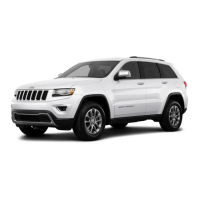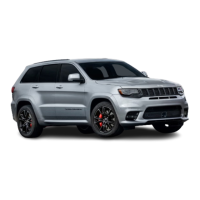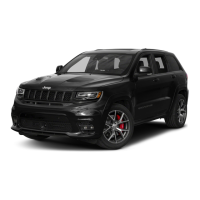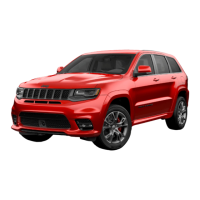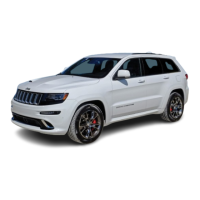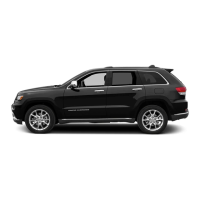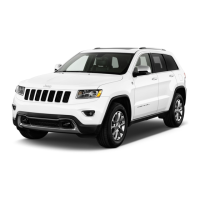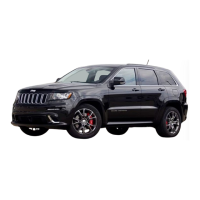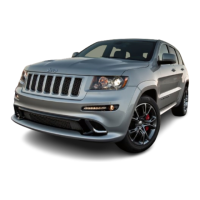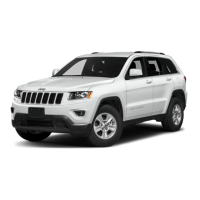
Do you have a question about the Jeep Grand Cherokee SRT 2014 and is the answer not in the manual?
| Brand | Jeep |
|---|---|
| Model | Grand Cherokee SRT 2014 |
| Category | Automobile |
| Language | English |
Highlights the increased rollover risk of utility vehicles due to higher center of gravity.
Manual contains warnings for safety and cautions for vehicle damage.
Warning about modifications affecting roadworthiness, safety, and potential injury or death.
Details how to lock, unlock, and use the panic alarm feature with the key fob.
Overview of the vehicle's restraint systems, including airbags, belts, and head restraints.
Details passive, deployable head restraints that minimize head gap in rear impacts.
Details advanced front, knee, and side air bags as supplements to seat belts.
Table summarizing recommendations for restraining children based on size and age.
Specifies the appropriate type of child restraint for different age/size categories.
Explains the LATCH system and its anchor points for installing child seats.
Strict warning against transporting passengers in the cargo area or any area without seats/belts.
Details passive, deployable head restraints that minimize head gap in rear impacts.
System uses radar sensors to detect vehicles in blind spot zones.
Explains the ASSIST button for roadside assistance and customer care support.
Instructions on how to make a 9-1-1 call and information transmitted to the operator.
Increases driving convenience via cruise control on highways and roadways.
Provides audible/visual warnings and may apply brake jerk for potential frontal collisions.
Provides visual and audible distance indications for rear/front fascia and detected obstacles.
Describes system faults, error messages, and conditions requiring service.
Allows viewing rear surroundings on-screen when shifting into REVERSE.
HomeLink® replaces handheld transmitters for garage doors, gates, lighting, security systems.
Details programming for garage door openers manufactured after 1995 with LEARN/TRAIN button.
Warning against operating the vehicle with the console compartment lid open.
Detailed descriptions of individual instrument cluster gauges and warning lights.
Explains the EVIC's driver-interactive display and its features.
Pre-start checks: seat, mirror adjustment, seatbelt fastening, and occupant instructions.
Warning against pouring fuel into throttle body to start a flooded engine.
Precautions to prevent transmission damage during shifting.
Driver-interactive feature for manual shift control, maximizing engine braking and performance.
Combines vehicle control systems for performance on various terrains.
Extra caution required for driving through water to ensure safety and prevent damage.
Ensure parking brake is fully applied and shift lever is in PARK before leaving vehicle.
System includes ABS, TCS, BAS, ERM, ESC for enhanced stability and control.
Aids driver in maintaining control under adverse braking by preventing wheel lock-up.
Monitors wheel spin, applies brake pressure and reduces engine power for stability.
Optimizes braking capability during emergencies by applying optimum pressure.
Anticipates wheel lift by monitoring steering input and speed, applies brake to reduce lift.
Enhances directional control and stability by correcting oversteer/understeer.
Importance of proper tire inflation for safety, economy, and ride comfort.
Warnings about improperly inflated tires causing collisions and damage.
Allows driving 50 miles at 55 mph after rapid inflation loss; needs immediate replacement.
Warnings for compact spares: speed limits, tread life, replacement, and failure risks.
Warnings for limited-use spares: affects handling, speed limits, inflation, replacement.
Warnings about unapproved tires/wheels affecting handling, steering, braking, and collision risk.
Warning about dangers of fast spinning tires: damage, failure, explosion, injury.
Warning against using tires with smaller load index or capacity, risking failure and loss of control.
Failure to equip with adequate speed capability tires can cause sudden failure and loss of control.
Advice on avoiding wheel spin above 30 mph or for longer than 30 seconds when stuck.
Run flat tire warning: check pressure, replace tire; limited driving capabilities.
Indicates TPM system fault with flashing/solid light, chime, and EVIC message.
Engine requires high-quality premium unleaded gasoline with 91 octane rating or higher.
Do not use gasoline with Methanol or >10% Ethanol; may cause starting/drivability problems.
Maximum permissible load on front and rear axles; distribute load evenly.
Warning against exceeding GVWR/GAWR; can cause parts breakage, affect handling, loss of control.
Total allowable weight of vehicle including driver, passengers, cargo, and tongue weight.
Maximum permissible load on front and rear axles; load must be distributed evenly.
Load trailer with 60% weight in front; 10% GTW on hitch; avoid rear imbalance.
Cautions against towing during first 500 miles and exceeding 50 mph when towing.
Guidelines for safe trailer towing to prevent collision.
Ensure trailer load is secured to prevent shifts, which can cause loss of control.
Avoid overloading vehicle/trailer; can cause loss of control, poor performance, damage.
Safety chains must always be used between vehicle and trailer, connect to hitch retainers.
Do not park vehicles with trailers on grades; apply parking brake, block wheels.
Warning against connecting trailer brakes to vehicle hydraulic lines; can cause failure.
Towing increases stopping distance; allow extra space; failure to do so causes accidents.
How to turn on/off hazard flashers; emergency use only when vehicle is disabled.
Actions to reduce overheating: slow down, turn off A/C, use heater, check coolant.
Warnings and instructions for safely changing a tire using the jack.
Procedures and safety precautions for jump-starting a discharged battery.
Procedure to manually release parking brake for moving vehicle when transmission won't shift.
Requires towing with all wheels OFF ground using a flatbed; other methods cause damage.
Monitors emissions, engine, and transmission systems; MIL illuminates if service needed.
Details required maintenance services for vehicle warranty, performance, and reliability.
Warnings about hot cooling system; checks for coolant level, bottle, hoses, and leaks.
Services must be done at specified times/mileages for warranty, performance, reliability.
How to report vehicle defects causing crash/injury/death to NHTSA and manufacturer.
